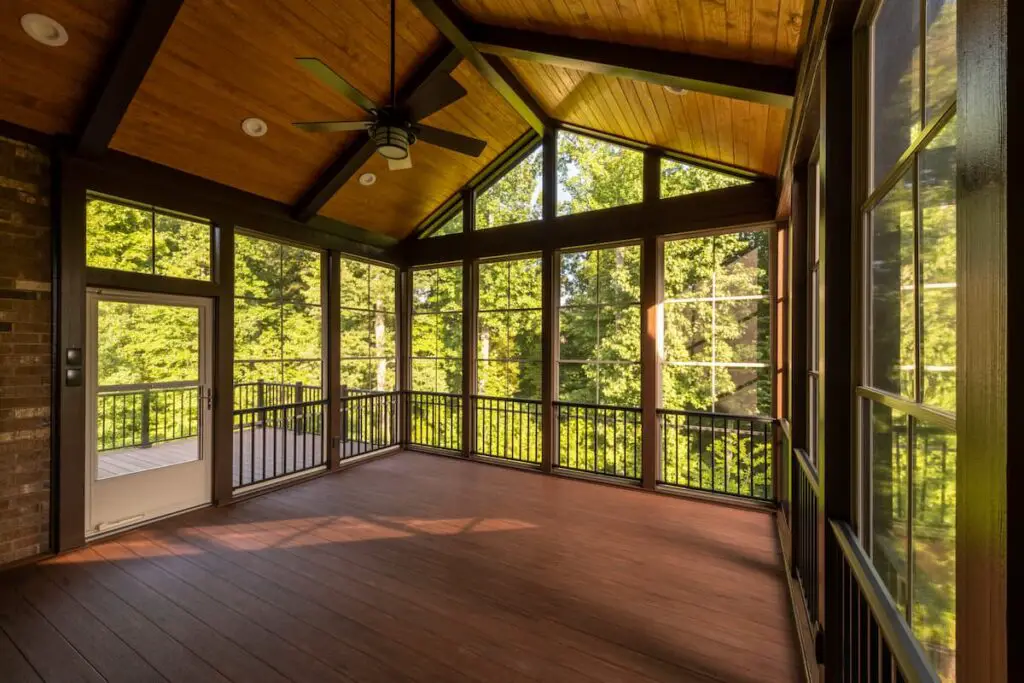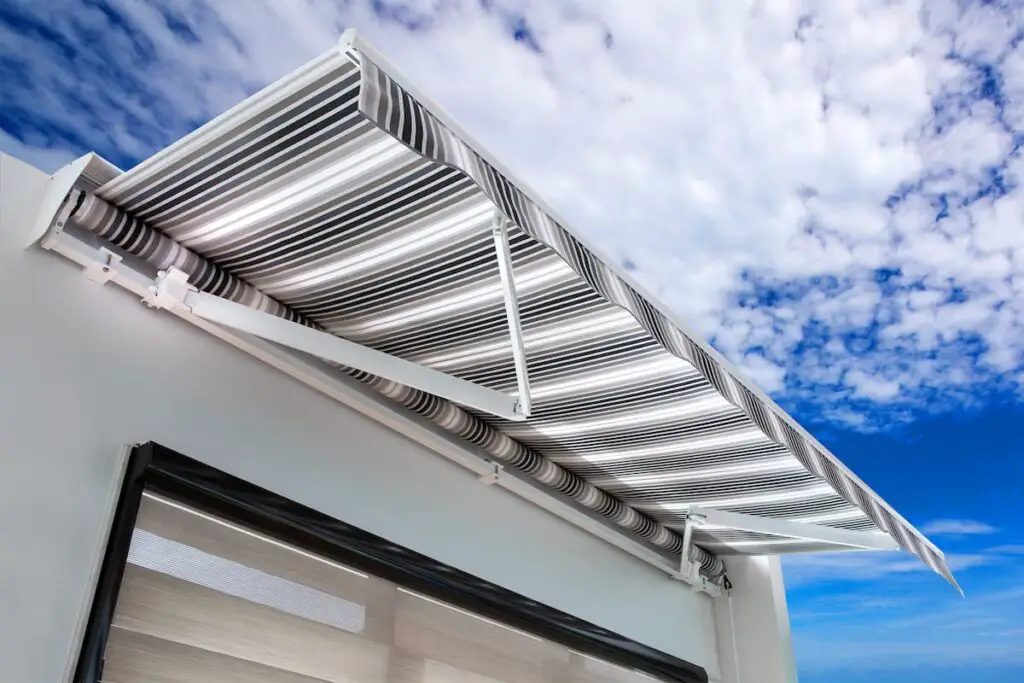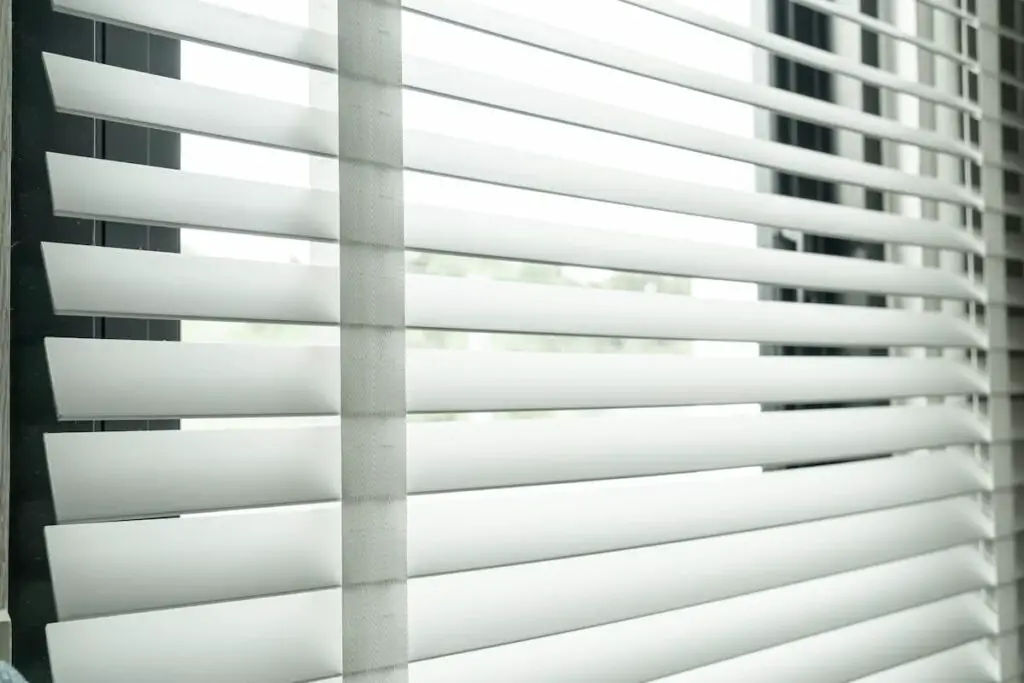As an Amazon Associate, we earn from qualifying purchases. We may also earn commissions if you purchase products from other retailers after clicking on a link from our site.
A screened-in porch is the best place to enjoy the outdoors while staying protected from the scorching summer sun, mosquitoes, and billowing storms. However, sometimes, the rain makes its way in through the screen, dampening your furniture, flooring, and mood. So, how do you keep the rain from getting into your screened-in porch?
Here’s how to keep the rain out of a screened-in porch:
- Install storm windows or window shades.
- Install overhanging awnings.
- Install jalousie windows.
- Landscape for rain control.
- Install lean-to roofs.
- Use plastic sheets.
So, let’s look at these tips in detail and discuss how you can weatherproof your screened-in porch. I’ll offer some quick fixes and permanent solutions and tell you how to implement them so you can protect your porch in any weather.

1. Install Storm Windows or Window Shades
Although a screened porch provides shade and protection from bugs, it may not protect you from the rain, especially when accompanied by strong winds. If your furniture isn’t waterproof, you’ll always have to push it aside so it doesn’t get wet.
So, installing storm windows or weather-resistant window shades is a clever way to keep the rain away from your porch.
Storm windows provide a great defense against weather elements. They’re usually made from fiberglass or glass with screens for ventilation. However, since they resemble standard house windows, storm windows could change the atmosphere of your porch, making it feel like you’re indoors.
On the downside, installing storm windows can cost you a fortune since they’re pricey. In addition, you’ll have to set up a firm structure to support the windows.
So what’s the alternative?
You can go for weather-resistant window shades.
Window shades, also known as rain curtains, are sheets that roll down to protect an opening, like a screen, from the weather. Although they might not block heavy rains or storms, they’re effective in keeping light showers from getting into your porch. Moreover, you can find customized window shades that match your porch screens’ size and style.
Window shades are affordable and available in various colors and fabrics. Some consist of waterproof materials such as vinyl, oilcloth, or Gore-Tex, providing you with durable, rain-blocking defenses. You can also secure them at the bottom during those rainy days or roll them up when not in use.
2. Install Overhanging Awnings
Whether temporary or fixed, overhanging awnings can extend your roof and keep the rain away. They will also protect your screened-in porch from strong winds and hailstorms, providing you with a shield against the weather. You can easily install the retractable ones on your own, but you need a professional to fix permanent awnings.
Overhanging awnings will cost you less than installing storm windows and almost the same price as rain curtains. One of the advantages of awnings is that you don’t have to put them away during summer, and they offer an ideal shade from the scorching sun.

3.Install Jalousie Windows
Jalousie windows or louvers are an alternative to storm windows, especially for coastal residents.
These paneled windows allow you to control the vents in your window while retaining the outdoor view. When completely closed, louvers will protect your porch from the pounding rain.
Although jalousie windows aren’t so common these days, they effectively keep your screened-in porch dry in wet weather. While most louvers are glass, you can still find plastic or aluminum models. However, you’ll need to keep them clean for a better outdoor view. So, be sure to factor in the maintenance of this rain-proof solution.

4. Landscape for Rain Control
Permanent solutions are usually the best, most cost-effective methods for preventing the weather from invading your personal space. So, how about permanently blocking the rain using a natural approach? Landscaping could be a great way to protect your screened-in porch from harsh weather, including heavy rainfall, storms, and winds.
Planting trees or shrubs in front of your porch screens will provide a natural barrier against rainfall. Additionally, having plants around will minimize water splashing and deflect it away. Although they can’t keep every drop away, they’ll reduce the need for expensive rain-blocking alternatives.
However, they’ll also block your view of other sceneries within your vicinity.
Although trees are a permanent solution, it will take time before you can experience their impact. Still, to help develop a solid barrier as quickly as possible, you can go for fast-growing species, especially those native to your region.
Also, it is best to plant trees 8 feet (2.4 m) away from your porch to avoid damage from falls or roots growing beneath your home. Shrubs are less hazardous, and you should place them around 2 feet (0.6 m) from your porch’s foundation.
5. Install Lean-to Roofs
Another permanent solution to preventing rainfall from invading your screened porch is installing a lean-to roof. These types of roofs have a single slope attached to a building. So, they’re ideal for outdoor spaces, including porches, patios, and balconies.
Lean-to roofs are affordable and easy to install. They’re made from various materials such as glass, polycarbonate, or clay tiles. The perfect roofing material will depend on availability and your preferences.
You don’t have to install additional waterproofing materials with a lean-to roof on your screened-in porch. However, gutters and downspouts are recommendable additions if you want to collect or drain water effectively. Gutters will help you save rainwater, while downspouts will shed it off directly to the ground.
6. Install Plastic Sheets
If none of the methods mentioned above suits your preferences, you can install plastic sheets over the porch screen for a temporary fix. These flimsy sheets are what many people use on their windows during winter to insulate them. However, they can also keep the rain from pouring into your screened-in porch.
Flimsy plastic sheets are available in different dimensions, and you can tailor them to fit your porch’s size. After trimming them to the correct size, you can use tape or staples to fix them onto the screen.
However, plastic sheets are merely a temporary solution. In addition, they’ll hinder you from enjoying the outdoor view since they aren’t transparent.
Final Thoughts
Watching the rain pour can be a therapeutic way of spending those lazy afternoons on your screened-in porch. However, being soaked in the rain or getting your furniture wet is far from a pleasant experience. Hence, it’s crucial to find an effective way to keep the rain away from your screened-in porch.
Depending on what works best for you, you can choose a temporary or permanent solution. Here are some approaches to consider:
- Installing storm windows or window shades
- Installing overhanging awnings
- Installing jalousie windows
- Landscaping for rain control
- Installing lean-to roofs
- Using plastic sheets or tarps
